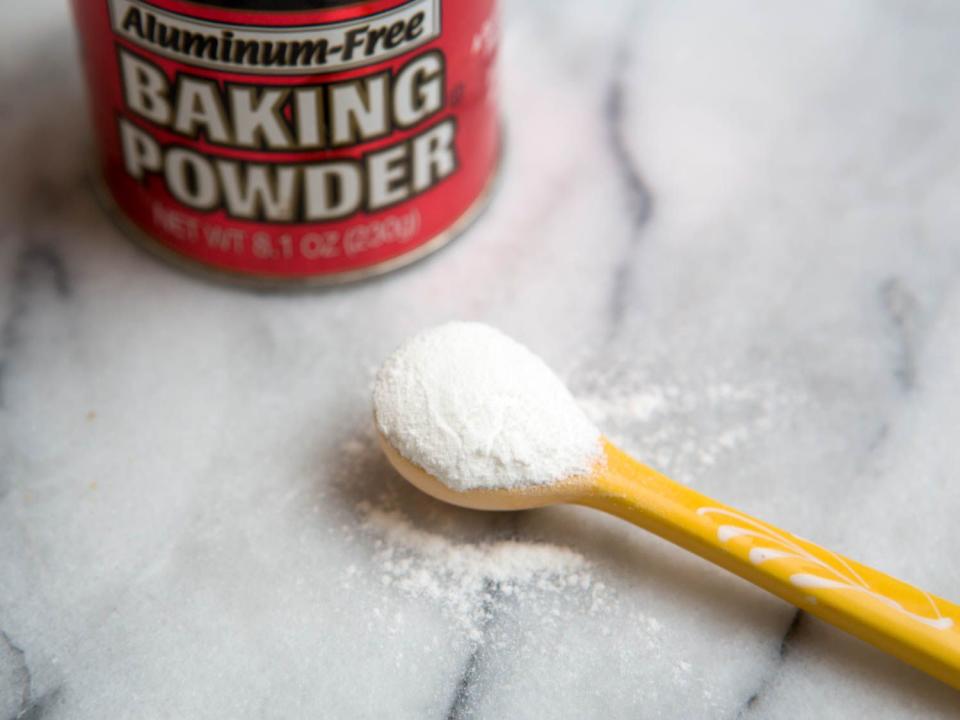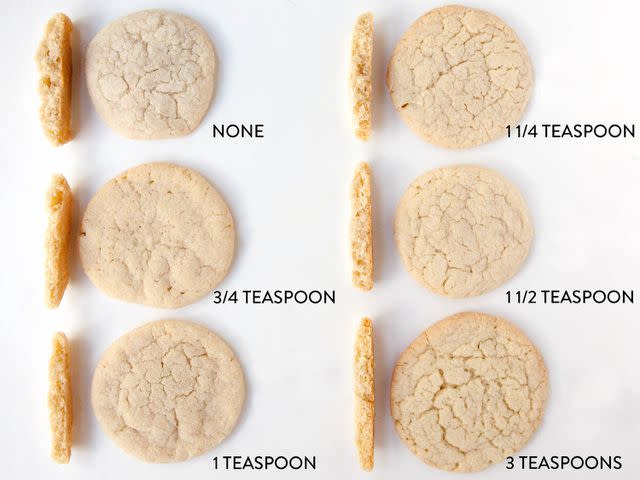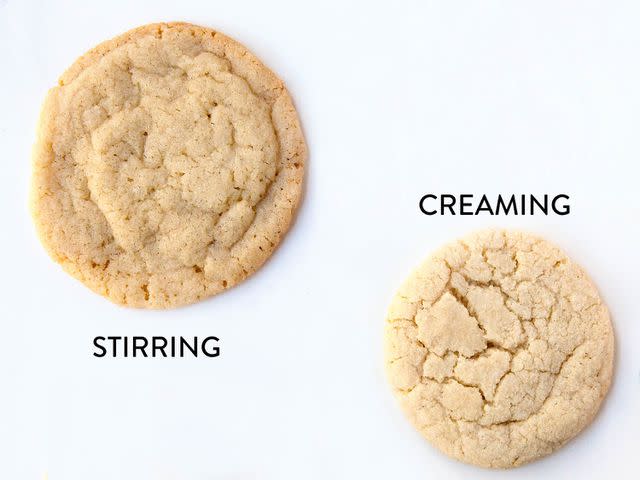How Does Baking Powder Affect My Cookies?
Everything you need to know about this versatile leavening agent and the role it plays in cookie doughs.

Serious Eats / Sarah Jane Sanders
Stop worrying about your baking powder.We'll get to the cookies, but first, a little history.
What Is Baking Powder?
Baking powder is a two-in-one chemical leavening that combines a powdered alkali (sodium bicarbonate) with a powdered acid (originally, tartaric acid). When moistened in a dough or batter, a chemical reaction takes place that produces carbon dioxide gas, inflating cookies, cakes, and pancakes. Because baking powder combines both an acid and a base, it eliminates the need for ingredients like buttermilk or sour cream to activate the sodium bicarbonate, allowing milk or even water to set off the reaction.
Long before the internet, folks at home knew how to do the exact same thing with baking soda and cream of tartar, so baking powder didn't prove an instant commercial success. To make baking powder more affordable than DIY alternatives, manufacturers lowered the cost by replacing expensive tartaric acid (an imported by-product of winemaking) with monocalcium phosphate (domestically produced from calcium and phosphorus).
Even so, baking powder didn't truly take off until the 1890s, when companies introduced "double-acting" formulas by adding sodium aluminum sulfate. Though acidic by nature, this insoluble crystalline powder refuses to interact with sodium bicarbonate unless fully melted, delaying any reaction until it's warmed above 140°F.
So why use two acids? In double-acting formulas, the moisture-sensitive acid is meant to prime (not leaven!) the dough, seeding it with carbon dioxide. Then the heat-sensitive acid kicks in right as cakes and cookies need it most—about midway through the baking process, when softly set batters and doughs threaten to collapse.
Don't Bother With Homemade Baking Powder
It's that one-two punch that makes modern baking powder so effective, and why I don't recommend DIY alternatives at home. Totally better than nothing at all, but according to the Handbook of Food Products Manufacturing, such "single-acting" baking powders expend 75% of their carbon dioxide before even reaching the oven.
That said, cookies are far more forgiving than cakes, in part because their comparatively low moisture content prevents sodium bicarbonate and acid from truly interacting until the butter melts (hence, cookie dough is happy to chill in the fridge). In double-acting formulas, there's no need to fear; worst-case scenario, the first dose of carbon dioxide is wasted, but the second hits the oven rarin' to go.
Barring some sort of cookie crisis that necessitates MacGyvering (or MacGrubering) through a recipe, single-acting baking powders are all but obsolete. When cookies call for baking powder, the "double-acting" part should go without saying.
How Much Baking Powder Do My Cookies Need?
The exact amount a recipe will need varies depending on how long the cookies bake, i.e., how long the supply of carbon dioxide needs to last. Expect about one teaspoon per five ounces of flour; thin and crispy cookies may need a little less, thick and chewy cookies may need a little more.
Even without baking powder, a well-aerated dough will still puff with steam. If that supply cuts off before the cookies set, a soft dough will collapse in on itself. If it continues until the end, the air pockets are preserved as the cookie's crumb.
Baking powder simply adds carbon dioxide to the equation, providing a more forceful pressure that encourages a dough to spread up and out. Without the well-developed elasticity of a bread dough, the strands of gluten in cookies would sooner snap than stretch, cracking along the surface. That gives cookies their familiar appearance, but if you keep pushing the dough with more carbon dioxide, those cracks will only deepen.

Serious Eats / Sarah Jane Sanders
In this series of photos, you can see that as we increase the baking powder, the cookies tend to rise a little more, but only to a certain point. Eventually, the reaction is so strong and violent that it will actually cause those air pockets to rupture and collapse, delivering a denser, squatter cookie.
So, contrary to popular belief, it's not excess baking powder that makes a cookie cakey. Baking powder just regulates how air cells expand—whether or not a dough can handle that expansion depends on gluten. Recipes that are relatively acidic, lean, low in sugar, and high in moisture favor gluten development. Recipes that are relatively alkaline, rich, high in sugar, and low in moisture don't. You can't change that with baking powder—you can only cram a dough with more chemicals than it can burn off in a given time, leaving a funky taste behind.
With Baking Powder, Brand Doesn't Matter
The brand of double-acting baking powder you use isn't that important. Different companies use different blends of starches, alkalis, and acids, and some may offer various certifications (gluten-free, kosher, etc.), but they're all formulated to produce a two-stage reaction to a relatively equivalent degree.
I keep Clabber Girl at home, but I don't owe it any particular allegiance (it's what they sell at Sam's Club, my one-stop chemical shop). It has the same blend of ingredients that popularized baking powder 120 years ago, so I figure it's tried and true.
When comparing labels, keep in mind that the ingredients in baking powder are meant to fuel a chemical reaction. Unless something goes awry, those ingredients aren't in the final product. For example, it's impossible to taste sodium aluminum sulfate in cookies because it's not there: It reacts with sodium bicarbonate to evolve into carbon dioxide, sodium, water, and aluminum hydroxide—an odorless mineral. Meanwhile, what's touted as a tastier alternative, sodium acid pyrophosphate, produces carbon dioxide, water, and trisodium pyrophosphate—an inherently bitter acid.
Store Your Baking Powder Cool and Dry
Whatever kind you choose, store your baking powder someplace cool and dry. Packages generally indicate a six-month shelf life, but there's little concern of being ambushed by bad powder.
Baking powder's chief ingredients, cornstarch and sodium bicarbonate, are outrageously stable even in abusive storage conditions, and its most important acid is defined by an inability to react with water. Hypothetically, the moisture-sensitive acid could be activated prematurely, but liquid water would be created as a by-product of that reaction, causing the cornstarch to visibly cake, clump, and pill.
Bad Cookies? It's Probably Not the Baking Powder's Fault
My personal theory is that a lack of aeration (from under-creaming or ultra-soft butter) is the real reason trusted recipes sometimes fall flat.

Serious Eats / Sarah Jane Sanders
Check it out: both of the sugar cookies above contain the exact same amount of baking powder. I made the batch on the left with room-temperature butter, using a stand mixer to stir rather than cream in the sugar. I made the batch on the right by creaming cool butter and sugar until light and fluffy.
With proper creaming to incorporate countless tiny pockets of air for the carbon dioxide to expand, my sugar cookies puffed up light. Without aeration to provide a foothold in the dough, the carbon dioxide simply tunneled out, erupting in ugly wormholes. See those dark spots?
If you didn't understand the importance of creaming or the fact that squishy butter won't retain air, it'd be easy to blame "bad" baking powder. So, instead of tossing out a perfectly good tin, check your technique instead. In a lifetime of baking, 10 years of professional kitchen work, five years of troubleshooting recipes online, and the formal recipe-testing process that goes into writing a cookbook, I've yet to encounter a single baking powder–based failure.
Then again, I've never been struck by lightning. It could technically happen, but the odds are not, as the kids say, ever in your favor.
If you're still worried, put a tablespoon of double-acting baking powder into the bottom of a tall drinking glass, add three ounces of boiling water, and watch it foam to the top. If it doesn't, check the date on the package and shoot me an email—I'm trying to determine the real-world upper limit, but haven't found it yet.
December 2015
Read the original article on Serious Eats.

